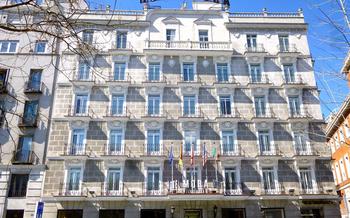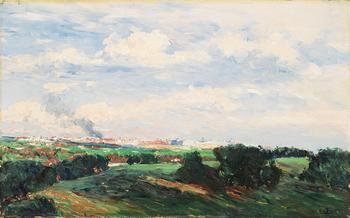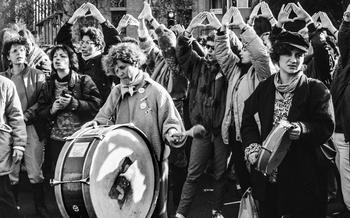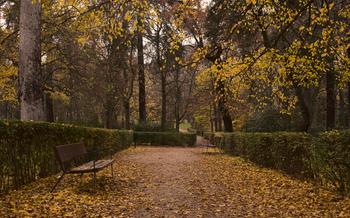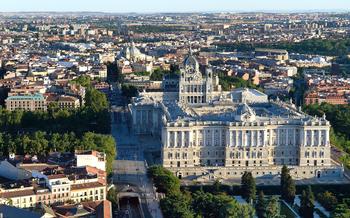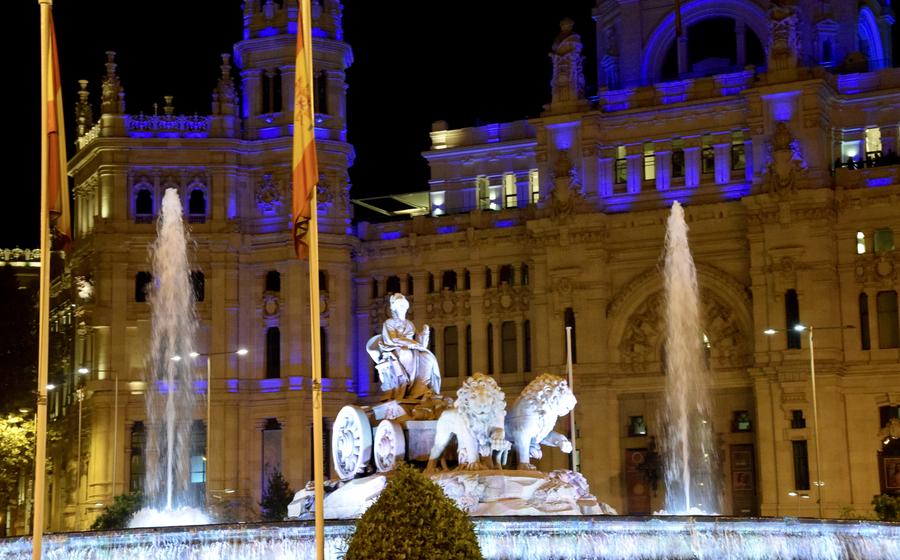
Cybele Palace
- Cybele Palace: A Historical Monument in Madrid
- Exploring the Exterior of the Cybele Palace
- Unveiling the Interior of the Cybele Palace
- The Cybele Palace as a Cultural Venue
- The History of the Cybele Palace: A Journey Through Time
- The Architectural Legacy of the Cybele Palace
- Discovering the Fountain of Cybele
- The Cybele Palace as a Symbol of Madrid
- Visiting the Cybele Palace: Practical Information
- Unveiling the Hidden Gems of the Cybele Palace
- Experiencing Madrid's Cultural Scene at the Cybele Palace
- Capturing the Essence of the Cybele Palace
- Insider Tip: Exploring the Cybele Palace at Night
Cybele Palace: A Historical Monument in Madrid
The Cybele Palace, an architectural gem nestled in the heart of Madrid, stands as a testament to the city's rich history and cultural heritage. Constructed in the late 18th century, the palace initially served as the headquarters of the General Post Office. Its transformation into a cultural center began in the early 20th century, and today, it houses the renowned CentroCentro cultural center, hosting prestigious exhibitions, concerts, and cultural events.
The Cybele Palace boasts an impressive neoclassical facade, adorned with intricate carvings and sculptures. Its iconic fountain, featuring the Roman goddess Cybele riding a chariot drawn by lions, has become a symbol of Madrid, attracting visitors from around the world. The allegorical statues adorning the palace's exterior, representing virtues such as prudence, temperance, and justice, add to its grandeur.
Exploring the Exterior of the Cybele Palace
As you approach the Cybele Palace, its grand neoclassical facade will captivate your attention. Admire the intricate carvings and sculptures that adorn the building, each telling a unique story. The iconic fountain in front of the palace is a must-see, featuring a majestic statue of the goddess Cybele riding a chariot pulled by lions. Take a moment to photograph this iconic landmark and capture its beauty.
Don't miss the allegorical statues that flank the palace entrance, representing the virtues of Madrid and Spain. These impressive figures add to the building's grandeur and provide a glimpse into the city's rich history. Finally, take note of the city's coat of arms, proudly displayed on the facade, symbolizing Madrid's identity and heritage.
Unveiling the Interior of the Cybele Palace
Stepping inside the Cybele Palace is like embarking on a journey through time and art. The grand reception rooms, adorned with intricate chandeliers and opulent furnishings, transport visitors to a bygone era of grandeur and elegance. Each room tells a story, showcasing the palace's rich history and connection to Madrid's past.
The exhibition halls, with their soaring ceilings and natural light, provide a stunning backdrop for diverse art collections. From classical sculptures to contemporary masterpieces, the palace offers a feast for the eyes. Temporary exhibitions, showcasing the works of renowned artists from around the world, add to the palace's dynamic cultural offering.
Visitors can take advantage of the free guided tours, led by knowledgeable and passionate experts, who share fascinating insights into the palace's history, architecture, and art collections. These tours offer a deeper understanding of the palace's significance and allow visitors to uncover hidden stories and details that would otherwise go unnoticed.
The Cybele Palace as a Cultural Venue
The Cybele Palace stands as a vibrant cultural hub in the heart of Madrid, playing host to a diverse array of exhibitions, events, and performances that cater to a wide range of interests. Visitors can immerse themselves in captivating art exhibitions, showcasing both established and emerging artists from around the world. The palace's grand halls and galleries provide a stunning backdrop for these displays, enhancing the impact of each artwork.
Throughout the year, the Cybele Palace transforms into a stage for cultural events and concerts, bringing together talented musicians, dancers, and performers. Classical concerts fill the air with enchanting melodies, while contemporary dance performances captivate audiences with their innovative choreography. The palace's versatile spaces accommodate a variety of events, from intimate recitals to grand theatrical productions, ensuring a memorable experience for all attendees.
The Cybele Palace also embraces its role as an educational institution, offering a range of programs and workshops designed to foster creativity and knowledge. Art enthusiasts can participate in hands-on workshops, led by experienced artists, where they can hone their skills and explore different artistic techniques. Lectures and seminars delve into the history of art, providing insights into the lives and works of renowned artists. The palace's commitment to education extends to younger visitors as well, with interactive programs designed to spark their imaginations and nurture their appreciation for the arts.
The History of the Cybele Palace: A Journey Through Time
The origins of the Cybele Palace can be traced back to the 18th century when it was commissioned by King Charles III as a royal post office. Designed by renowned architect Ventura Rodríguez, the building initially served as the city's main post office and was known as the "General Post Office and Royal Customs House." Its strategic location near the Puerta del Sol, the city's central square, made it a hub of communication and commerce.
Over the years, the Cybele Palace underwent several transformations and renovations. In the mid-19th century, it was expanded and remodeled by architect Antonio López Aguado, who added the iconic fountain and the allegorical statues that adorn the facade. The palace's purpose also shifted, and it began to house the Ministry of Public Works, playing a crucial role in Spain's infrastructure development.
It was not until the late 20th century that the Cybele Palace underwent its most significant renovation. In 1992, the building was meticulously restored and transformed into a cultural center, becoming the current home of the Madrid City Council. This renovation breathed new life into the palace, preserving its historical essence while adapting it to modern-day use as a vibrant cultural venue.
Throughout its history, the Cybele Palace has been witness to significant events and played a pivotal role in Madrid's development. Its transition from a post office to a ministry building and finally to a cultural center reflects the city's evolving needs and aspirations. Today, the Cybele Palace stands as a testament to Madrid's rich heritage, blending historical significance with contemporary cultural expression.
The Architectural Legacy of the Cybele Palace
The Cybele Palace stands as a testament to the enduring legacy of neoclassical architecture. Its symmetrical design, intricate carvings, and symbolic sculptures reflect the artistic ideals of the 18th century. The palace's facade is adorned with a row of imposing columns, creating a sense of grandeur and monumentality. The intricate carvings depict mythological scenes and allegorical figures, adding a layer of visual interest and symbolism to the building.
The most striking feature of the palace's exterior is its pediment, which showcases a sculptural composition representing the triumph of Cybele, the goddess of nature and fertility. This elaborate ensemble of figures and symbols captures the essence of the palace's dedication to the goddess and adds a touch of mythological grandeur to the building.
The Cybele Palace is not merely an architectural marvel but also a symbol of Madrid's rich history and cultural heritage. Its neoclassical style represents a period of enlightenment and artistic revival in the city, and the palace itself has played a significant role in shaping Madrid's urban landscape.
Discovering the Fountain of Cybele
In the heart of the Plaza de Cibeles, the iconic Fountain of Cybele stands as a majestic symbol of Madrid. Unveiled in 1782, this neoclassical masterpiece is a testament to the city's rich history and artistic heritage. The fountain takes its name from the Roman goddess Cybele, who is depicted as a majestic figure riding a chariot drawn by two magnificent lions. The allegorical representation symbolizes the earth's fertility and abundance, highlighting Madrid's role as a thriving metropolis and a hub of commerce.
With its intricate carvings, allegorical sculptures, and cascading waters, the Fountain of Cybele has become an instantly recognizable landmark, capturing the hearts and imaginations of visitors worldwide. Its beauty and grandeur have made it a popular subject for photographers, artists, and filmmakers, earning it a place among Madrid's most iconic symbols. Despite its controversial history, involving disputes over its design and location, the fountain remains a beloved landmark, deeply embedded in the cultural fabric of the city.
The Cybele Palace as a Symbol of Madrid
The Cybele Palace holds a special place in the hearts of Madrileños, embodying the city's rich history, cultural vibrancy, and festive spirit. As a symbol of the city, the palace is deeply intertwined with local traditions and celebrations. During the annual festivities of San Isidro, Madrid's patron saint, the palace becomes a focal point of the city's celebrations. The surrounding streets burst with life and color as locals and visitors gather to enjoy traditional music, dance performances, and a captivating fireworks display that illuminates the sky above the palace.
The palace's iconic fountain, with its majestic figure of Cybele, the Greek goddess of nature, serves as a gathering place for locals and a popular meeting point for friends and families. During football matches, the fountain transforms into a sea of red and white as fans gather to celebrate victories and commiserate after defeats. The palace also plays a significant role in the city's Christmas celebrations, when its grand facade is adorned with dazzling lights, creating a magical atmosphere that draws visitors from far and wide.
Visiting the Cybele Palace: Practical Information
Opening Hours and Admission Fees: The Cybele Palace is usually open to the public from Tuesday to Sunday, with extended hours on weekends. Admission fees are typically charged and may vary depending on special exhibitions or events. However, certain days or time slots may offer free entry, so checking the official website or inquiring at the ticket counter is recommended. Guided tours are available for a slightly higher fee and provide an in-depth exploration of the palace's history and architecture.
Directions and Transportation Options: The Cybele Palace is conveniently located in the heart of Madrid, making it easily accessible by various transportation means. Metro stations like Banco de España and Sevilla are just a short walk away, connecting visitors to the rest of the city. For those who prefer a scenic approach, the iconic red double-decker buses or local taxis can be utilized to reach the palace.
Nearby Attractions and Restaurants: The Cybele Palace is surrounded by a wealth of attractions, including the iconic Retiro Park, known for its tranquil gardens and crystal palace. The nearby Prado Museum, housing a renowned collection of European art, is a must-visit for art enthusiasts. Along the Paseo del Prado, visitors can also explore the Thyssen-Bornemisza Museum and the CaixaForum cultural center. For a culinary experience, the surrounding area offers a variety of restaurants catering to diverse tastes, from traditional Spanish cuisine to international flavors.
Best Time to Visit: The Cybele Palace can be visited year-round, but the best time to fully appreciate its beauty and vibrant atmosphere is during the spring or fall. During these seasons, the weather is pleasant for outdoor exploration, and the palace gardens are in full bloom. Additionally, the Christmas season brings a magical touch to the palace with its festive illuminations and decorations, making it a popular destination for locals and tourists alike.
Unveiling the Hidden Gems of the Cybele Palace
Beyond the grand halls and exhibition spaces, the Cybele Palace holds a treasure trove of hidden gems waiting to be discovered by curious explorers. Secret passageways lead to secluded courtyards adorned with intricate carvings and sculptures. These hidden corners provide a glimpse into the palace's rich history and offer a tranquil escape from the bustling city outside.
Art enthusiasts can embark on a treasure hunt, uncovering hidden works of art and sculptures tucked away in unexpected nooks and crannies. From delicate paintings to captivating sculptures, these hidden gems showcase the artistic prowess of past masters and provide a deeper appreciation for the palace's cultural significance.
Lesser-known exhibits and galleries reveal untold stories and perspectives, inviting visitors to delve into the palace's rich history and diverse collections. These hidden gems offer a unique opportunity to gain exclusive insights into the palace's past and present, shedding light on its intriguing evolution over time.
Unveiling the palace's hidden gems is like embarking on a thrilling adventure, where every corner holds the potential for discovery. Whether it's a secret passageway, a hidden work of art, or a forgotten exhibit, these hidden treasures add layers of intrigue and fascination to the already captivating Cybele Palace.
Experiencing Madrid's Cultural Scene at the Cybele Palace
The Cybele Palace is not just a historical monument but also a vibrant cultural hub in Madrid. Throughout the year, the palace hosts a diverse array of cultural events, performances, and exhibitions that showcase the city's rich artistic heritage. From classical concerts to contemporary art exhibitions, there's something for every taste and interest. Visitors can attend captivating performances by local and international artists, immerse themselves in thought-provoking exhibitions, or participate in educational workshops and programs. The Cybele Palace provides a platform for emerging artists to showcase their work, fostering a dynamic and thriving cultural scene in Madrid. Whether you're an art enthusiast, a music lover, or simply seeking a unique cultural experience, the Cybele Palace offers an unforgettable journey into the heart of Madrid's vibrant cultural landscape.
Capturing the Essence of the Cybele Palace
The Cybele Palace, with its captivating beauty and historical significance, inspires artistic expression in various forms. Whether you are a budding photographer, a skilled painter, or a passionate writer, the palace offers a wealth of opportunities to capture its essence.
For photography enthusiasts, the palace and its surroundings present a stunning backdrop for capturing memorable images. From wide-angle shots that showcase the grandeur of the building to close-up details that reveal intricate architectural elements, there are countless opportunities to create striking compositions.
If you are drawn to the beauty of line and color, sketching or painting the Cybele Palace can be a rewarding experience. The palace's intricate facade, with its symmetrical design and ornate sculptures, offers a rich canvas for artistic interpretation. As you immerse yourself in the process of capturing its beauty, you will gain a deeper appreciation for the palace's architectural details.
For those who find inspiration in words, the Cybele Palace can be a muse for poetry or prose. The palace's history, its role in Madrid's cultural scene, and the emotions it evokes can serve as powerful sources of inspiration for creative writing. Whether you choose to write a poem that reflects the palace's grandeur or a short story that brings its history to life, the Cybele Palace offers a wealth of material to explore.
Sharing your experiences and impressions of the Cybele Palace with fellow travelers is another way to capture its essence. Through conversations, social media posts, or travel blogs, you can share your unique perspective on this iconic landmark and encourage others to discover its beauty and significance.
Insider Tip: Exploring the Cybele Palace at Night
For an unforgettable experience, visit the Cybele Palace after sunset when the city transforms into a magical realm. The illuminated fountain, with its cascading waters and colorful lights, creates a breathtaking spectacle that is sure to captivate your senses. Take your time to admire the intricate details of the palace facade, bathed in a warm glow that highlights its grandeur. Capture the beauty of the night scene with your camera, ensuring you have lasting memories of this enchanting moment. Afterward, take a leisurely stroll through the surrounding area, where the city's energy blends seamlessly with the tranquility of the palace grounds. This unique experience offers a glimpse into the hidden charm of the Cybele Palace, leaving you with a lasting impression of its allure.
